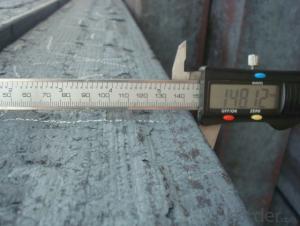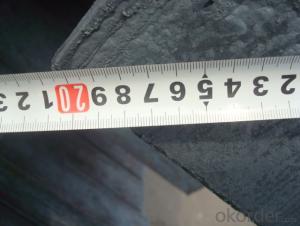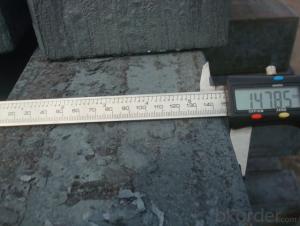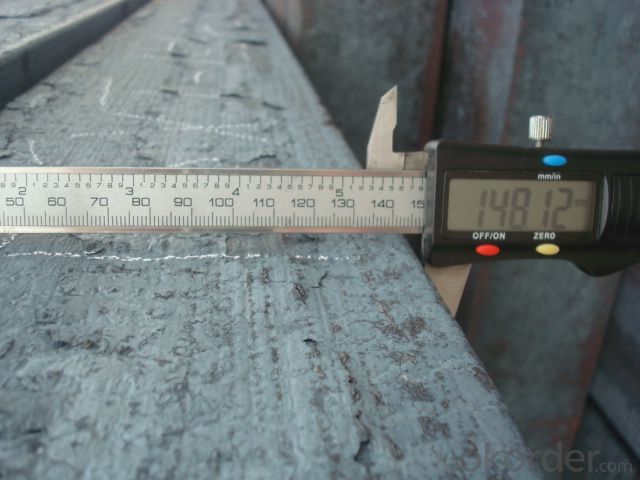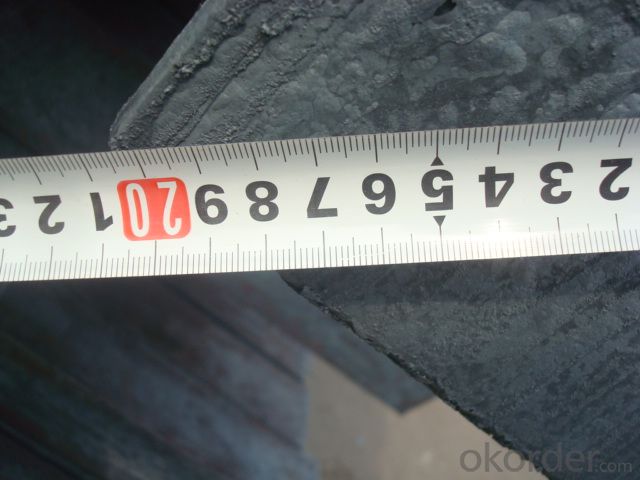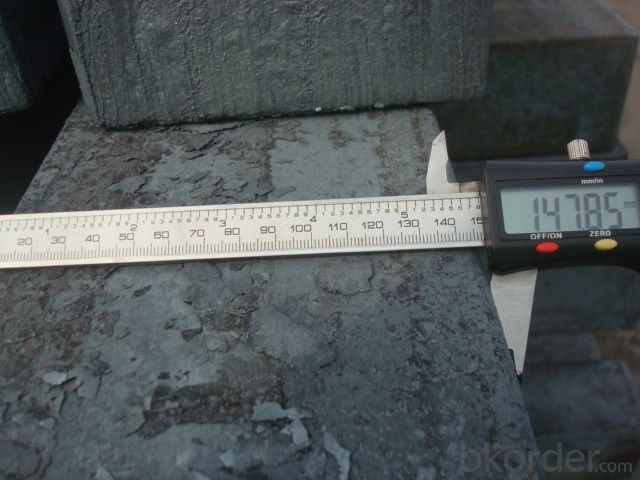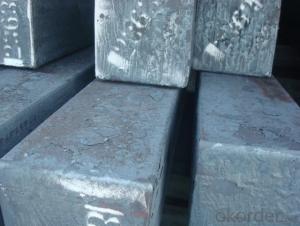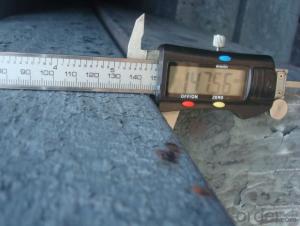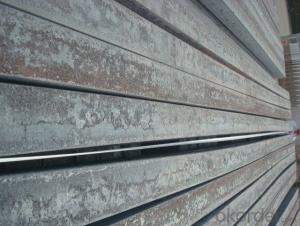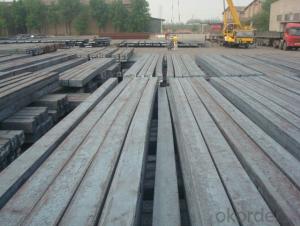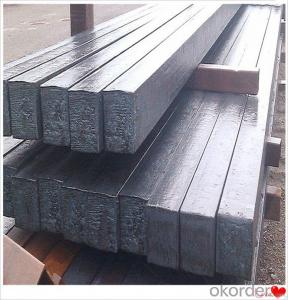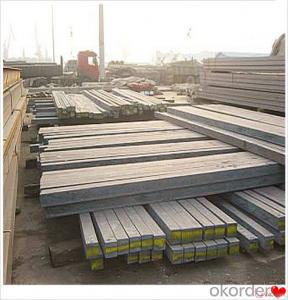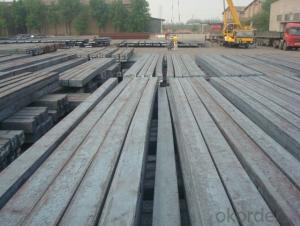Prime Steel Billet Q275, 20MnSi, 5SP,Q235
- Loading Port:
- Tianjin
- Payment Terms:
- TT OR LC
- Min Order Qty:
- 1000 m.t.
- Supply Capability:
- 20000 m.t./month
OKorder Service Pledge
OKorder Financial Service
You Might Also Like
STEEL BILLET
1.Brief description
Steel billet(ingot) by cogging or breakdown of semi-finished products, is the raw material of all kinds of steel mill. Billet section of square, round, flat, rectangular and abnormity of several kinds of, mainly related to the shape of rolled products.
2.Features
Rectangular billet continuous casting billet and mainly general carbon steel, low carbon low silicon cold-rolled material, high quality carbon structural steel, high strength low alloy steel, special steel, etc.
The billet is mainly divided into two kinds from the shape:
Slab: cross section width and height of the ratio of the larger, mainly used for rolling plate.
Billet: equal cross section width and height, or a huge difference, mainly used for rolling steel, wire rod. ,
Steel billets have distinct characteristics as compared with already furnished steel bars and products. Billets have a specific grain structure, which enables the metal to be processed more intricately. Steel billets are also known for their malleability and ductility, especially when exposed to varying temperatures during shaping and molding.
3.Processing
Steel billets are considered fresh and raw, and they must undergo a series of manufacturing processes before they can be used for various purposes. Billets are made by means of freezing molten liquid, and are later exposed to extremely low temperatures in order to allow the metal to take shape and solidify in chemical structure. The temperature manipulates the metal's physical properties, and tones its strength and durability. The subsequent processes provide the metal's curved mold design so that it can fit the allotted space provided by other machines, which complete the finishing procedures.
4.Pictures

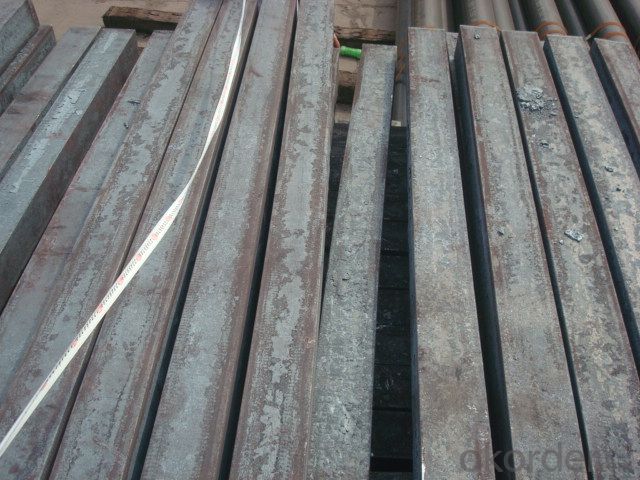
5.Usage
Billets, or ingots (as they sometimes referred to), are not of practical use until they have been formed into more functional shapes and sizes. While they have already been put in the furnace, they still require a series of shaping and molding procedures such as hot and cold working, milling and cutting before they are sold in hardware stores, or used for different applications. The unformed billets, however, can be used in striking currency such as coins and as reserves, similar to gold bars.
6.Detailed specification
Hot rolled billet steel
Size: 50x50mm-180x180mm
Steel Grade: 3SP, 5SP,Q195,Q235,Q255,Q275 Length:3m-12m
MOQ: 1000MT/size
Payment term: TT or LC
Packing: in bulk , bundle
Shipment: by container , bulk vessel
Packaging Details: bundles with steel strips or as customers's requirements
Delivery time: 15-30 days after the deposit
Loading port:Tianjin, or other port China
Origin : China
Inspection:Third party inspection before loading.
- Q: What are the different types of shearing machines used for steel billets?
- Steel billets can be cut using various types of shearing machines. These machines are designed for precise and efficient cutting operations in the steel industry. Here are some examples of the different shearing machines used for steel billets: 1. Guillotine Shears: Guillotine shears are widely used for cutting steel billets. They have a fixed bed and a vertically moving blade that cuts through the material. Guillotine shears offer high cutting accuracy and can easily handle thick billets. 2. Flying Shears: Also known as rotary shears, flying shears are another popular option. They have a circular blade that rotates and cuts the billet as it moves along the conveyor. Flying shears are known for their high cutting speed and ability to handle large volumes. 3. Cold Shears: Cold shears are designed to cut steel billets at lower temperatures to prevent heat damage. They use hydraulic or mechanical systems to apply force and cut through the billet. Cold shears are commonly used in industries where cooling the billets is necessary before further processing. 4. Rotary Shears: Rotary shears are used to cut steel billets into smaller sections. They have multiple blades mounted on a rotating drum, which cuts the billet into desired lengths. Rotary shears offer high cutting efficiency and are often used when small-sized billets are required. 5. Hydraulic Shears: Hydraulic shears are versatile machines that can cut various materials, including steel billets. They use hydraulic power to provide the cutting force. Hydraulic shears have a high cutting speed and can efficiently handle large-sized billets. Each type of shearing machine mentioned above has its own advantages and is suitable for specific applications in the steel industry. The choice of shearing machine depends on factors such as billet size and thickness, required cutting accuracy, production volume, and other specific requirements of the steel processing operation.
- Q: What are the different types of steel billet manipulation equipment?
- In the steel industry, there exists a variety of steel billet manipulation equipment. These machines serve the purpose of handling and manipulating semi-finished steel billets, which later undergo further processing to acquire different shapes and forms. The types of steel billet manipulation equipment are as follows: 1. Billet grabbers: Equipped with either hydraulic or mechanical arms, these machines possess the ability to securely grip and lift steel billets. They are commonly utilized for the loading and unloading of billets from storage areas, trucks, or trains. 2. Billet pushers: These machines find their utility in pushing steel billets along a conveyor system or into a furnace for additional processing. They are generally equipped with hydraulic systems that provide the necessary force to move the billets. 3. Billet transfer cars: Specialized vehicles, known as billet transfer cars, are employed for transporting steel billets within a steel plant. These vehicles feature a flat surface on which billets can be placed and moved from one location to another. 4. Billet cutting machines: These machines are dedicated to cutting steel billets into smaller pieces or removing excess material. They come in various configurations, such as circular saws, shearing machines, or abrasive cutting machines, and can be operated either manually or automatically. 5. Billet heating equipment: This category encompasses induction heating systems or furnaces used to heat steel billets to a specific temperature for further processing. These machines are indispensable in numerous heat treatment processes, including annealing or quenching. 6. Billet straightening machines: These machines are responsible for rectifying any deformations or bends that may occur during the billet manufacturing process. By applying controlled pressure and tension, they ensure that the billets are perfectly straight before proceeding to further processing. 7. Billet inspection equipment: These machines serve the purpose of inspecting the quality and dimensions of steel billets. They employ various techniques, such as ultrasonic testing, magnetic particle testing, or visual inspection, to identify any defects or flaws in the billets. Each type of steel billet manipulation equipment plays a vital role in the steel manufacturing process, guaranteeing the efficient handling, processing, and quality control of steel billets before they undergo transformation into finished products.
- Q: What are the different surface treatments for improved surface cleanliness in steel billets?
- There are several surface treatments available for improving surface cleanliness in steel billets, including shot blasting, pickling, acid cleaning, and electrochemical cleaning. Shot blasting involves propelling abrasive particles onto the surface to remove scale, rust, and contaminants. Pickling involves immersing the billets in an acid solution to dissolve oxides and surface impurities. Acid cleaning uses chemical solutions to remove surface contaminants and oxides. Electrochemical cleaning utilizes an electric current to remove oxides and impurities from the surface. These treatments help ensure better surface cleanliness and prepare the steel billets for further processing or applications.
- Q: What are the safety precautions when working with steel billets?
- When working with steel billets, it is important to follow certain safety precautions to prevent accidents and ensure a safe working environment. Here are some key safety measures to consider: 1. Personal Protective Equipment (PPE): Always wear the appropriate PPE, including steel-toed boots, safety goggles, gloves, and a hard hat. These items will protect you from potential hazards such as falling objects, sparks, and sharp edges. 2. Training and Education: Ensure that all workers are properly trained and educated on the handling and use of steel billets. This includes knowledge of safe operating procedures, material handling techniques, and emergency response protocols. 3. Safe Handling and Storage: Steel billets can be heavy and may cause injury if mishandled. Use proper lifting techniques and equipment to avoid strains or sprains. Additionally, store the billets in designated areas, properly stacked and secured to prevent them from falling and causing accidents. 4. Fire Safety Precautions: Steel billets can generate sparks when being moved or manipulated, which can ignite flammable materials. Keep the work area free from debris and flammable substances and ensure that fire extinguishers are easily accessible. 5. Machine Safety: If using machinery or equipment to handle the steel billets, make sure that they are well-maintained, properly guarded, and operated by trained personnel. Follow all operational instructions and perform routine safety checks to prevent accidents. 6. Adequate Ventilation: When working with steel billets, fumes and dust may be generated, especially during cutting or welding processes. Ensure proper ventilation is in place to remove these substances from the work area and reduce the risk of respiratory issues. 7. Emergency Preparedness: Have a well-defined emergency plan in place, including evacuation procedures, first aid facilities, and communication methods. Train all workers on emergency protocols and ensure that they are aware of the location of safety equipment and emergency exits. Remember, safety should always be the top priority when working with steel billets. Following these precautions will help to minimize the risk of accidents and promote a safe working environment for everyone involved.
- Q: What are the different types of tests conducted on steel billets?
- There are several different types of tests that are conducted on steel billets to ensure their quality and suitability for various applications. These tests are essential in determining the mechanical properties, chemical composition, and integrity of the steel billets. 1. Chemical Composition Analysis: This test involves examining the chemical composition of the steel billets to ensure that they meet the required standards and specifications. It measures the levels of various elements such as carbon, manganese, silicon, sulfur, and phosphorus. 2. Tensile Test: This test measures the tensile strength, yield strength, and elongation of the steel billets. It helps determine the ability of the steel to withstand pulling forces without breaking. 3. Hardness Test: This test determines the hardness of the steel billets, which is essential in evaluating their resistance to wear, deformation, and penetration. Commonly used hardness tests include Brinell, Rockwell, and Vickers tests. 4. Impact Test: This test measures the toughness and ability of the steel billets to absorb energy under impact or sudden loading conditions. It helps determine their resistance to fracture and cracking. 5. Ultrasonic Testing: This non-destructive test uses high-frequency sound waves to detect internal flaws or defects in the steel billets. It is commonly used to detect cracks, voids, and inclusions that may affect the structural integrity of the billets. 6. Dimensional Inspection: This test ensures that the steel billets meet the specified dimensional requirements, including length, width, and thickness. It ensures that the billets are suitable for their intended application and can be used in subsequent manufacturing processes without any issues. 7. Macroscopic Examination: This visual inspection involves examining the surface and internal structure of the steel billets using magnification. It helps identify any visible defects such as cracks, porosity, segregation, or any other irregularities. 8. Microscopic Examination: This test involves examining the microstructure of the steel billets using a microscope. It helps determine the grain size, presence of phases, and any abnormalities in the steel structure that may affect its properties. These tests collectively ensure that the steel billets meet the required quality standards and possess the necessary mechanical properties for their intended applications. They help ensure the safety, reliability, and performance of the steel billets in various industries such as construction, automotive, aerospace, and manufacturing.
- Q: What are the different types of steel billet forging defects?
- Some common types of steel billet forging defects include surface cracks, internal voids or cavities, improper grain flow, and dimensional inconsistencies. Other defects may include porosity, inclusions, and decarburization.
- Q: How are steel billets used in the production of agricultural irrigation systems?
- Agricultural irrigation systems necessitate steel billets as a crucial element. These semi-finished steel products are utilized to fabricate diverse components of irrigation systems, including pipes, fittings, and valves. In the manufacturing of irrigation pipes, steel billets are employed as the primary material that undergoes a series of processes to shape seamless or welded pipes. The billets are heated and subsequently passed through a piercing mill, where they are further elongated and molded into a hollow tube. Following this, the tubes are stretched and rolled to attain the desired diameter and thickness. As a result, the steel pipes produced are robust, long-lasting, and resistant to corrosion, making them ideal for agricultural irrigation systems. Moreover, steel billets are employed in the production of fittings and valves for irrigation systems. By shaping and machining steel billets, fittings such as elbows, tees, and reducers are manufactured to meet specific size and shape requirements. These fittings are pivotal in connecting and directing water flow within the irrigation system. Furthermore, steel billets are occasionally used in the fabrication of pump housings and other structural components of irrigation systems. Due to their strength and stability, steel billets provide the necessary support and durability required in these applications. In conclusion, steel billets play an essential role in the production of agricultural irrigation systems. They offer a reliable and robust material for pipes, fittings, valves, and other components. Their usage ensures the longevity and efficiency of these systems, facilitating effective water distribution and irrigation in agricultural fields.
- Q: How are steel billets used in the manufacturing of structural components?
- The manufacturing of structural components heavily relies on steel billets, which are an essential raw material. These billets, usually square or round in shape, are produced through continuous casting, a process that solidifies molten steel into a semi-finished product. After the formation of steel billets, they undergo further processing using different techniques like hot rolling, forging, or extrusion. Hot rolling includes heating the billets and passing them through a sequence of rollers to shape them into desired profiles, such as beams, channels, or angles. This method is crucial for achieving the necessary dimensions, strength, and surface finish. Forging is another technique employed with steel billets, involving heating the billets and shaping them using compressive forces. It is primarily used for manufacturing components that require enhanced strength and durability, like crankshafts, connecting rods, or turbine blades. Extrusion, on the other hand, is a specialized process that utilizes heated billets to create complex shapes by forcing them through a die. This technique is commonly utilized in the production of tubular components, such as pipes, tubes, or hollow sections. These components are extensively used in the construction of structures like bridges, buildings, or infrastructure. Steel billets play a critical role in the manufacturing of structural components by providing the necessary raw material that can be shaped using various fabrication techniques. Their adaptability and versatility make them an indispensable component in the construction industry, ensuring that buildings and structures possess the required strength and durability to withstand different loads and environmental conditions.
- Q: How are steel billets used in the production of agricultural machinery?
- Steel billets are used in the production of agricultural machinery as a raw material for various components such as gears, shafts, and frames. These billets are melted and molded into the desired shape, providing the necessary strength and durability required for the machinery to effectively perform tasks in the agricultural sector.
- Q: What are the weight ranges of steel billets?
- The weight ranges of steel billets can vary depending on the specific requirements and standards of the industry. However, typically, steel billets can range anywhere from a few kilograms to several metric tons in weight. The weight of a steel billet is determined by factors such as its dimensions, intended application, and production process. For smaller steel billets, such as those used in construction or manufacturing, the weight range may be between 1 to 10 kilograms. On the other hand, larger steel billets, commonly used in heavy machinery or infrastructure projects, can range from 10 to 100 metric tons or even more. It is important to note that these weight ranges are general estimates and can vary based on specific industry requirements and production capabilities.
Send your message to us
Prime Steel Billet Q275, 20MnSi, 5SP,Q235
- Loading Port:
- Tianjin
- Payment Terms:
- TT OR LC
- Min Order Qty:
- 1000 m.t.
- Supply Capability:
- 20000 m.t./month
OKorder Service Pledge
OKorder Financial Service
Similar products
Hot products
Hot Searches
Related keywords
